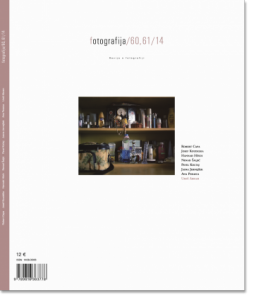 … In order to understand the significance of the award-wining series of works by Nenad Saljic, in both an international as well as local context, we need to delve deeper into the history of photography itself, and landscape photography in particular, as its own autonomous genre. Landscape photography, which is at the center of the author’s work, stands out among other genres in photography precisely because it does not capture a moment in time or the fleeting nature of objects, which is characteristic of the medium as a whole, particularly for journalistic or life photography. Landscape photography, in complete contrast to those genres, doesn’t capture a moment, but rather the persistence and stability of a geological timeframe, which routinely transcends time for both the observer, and the photographer. It is by virtue of their convergence that many questions arise, which also transcend the common themes of photography, and introduce wholly new concepts for perception and analysis, the psychological and metaphysical concepts in defining time, and the concept of lasting and temporality. This is also true of the geocosmic time present in the photographs of Nenad Saljic, which routinely showcases not only stars or massive rock formations, but also temporal weather conditions.
… In order to understand the significance of the award-wining series of works by Nenad Saljic, in both an international as well as local context, we need to delve deeper into the history of photography itself, and landscape photography in particular, as its own autonomous genre. Landscape photography, which is at the center of the author’s work, stands out among other genres in photography precisely because it does not capture a moment in time or the fleeting nature of objects, which is characteristic of the medium as a whole, particularly for journalistic or life photography. Landscape photography, in complete contrast to those genres, doesn’t capture a moment, but rather the persistence and stability of a geological timeframe, which routinely transcends time for both the observer, and the photographer. It is by virtue of their convergence that many questions arise, which also transcend the common themes of photography, and introduce wholly new concepts for perception and analysis, the psychological and metaphysical concepts in defining time, and the concept of lasting and temporality. This is also true of the geocosmic time present in the photographs of Nenad Saljic, which routinely showcases not only stars or massive rock formations, but also temporal weather conditions.
Landscapes such as this, once photographed, have an almost therapeutic effect upon the observer. For those of us who’ve not physically scaled mountains, particularly not at night, these photographs offer the opportunity of photographically facilitated meditation in nature, at a somewhat lesser, and thus less intimidating, scale, as well as an experience devoid of the physical and climatic hardships that the author might have encountered.
… Namely, landscape photography doesn’t portray just the landscape itself; rather, as can be seen in Saljic’s work, it also includes the complex relationship between author and object. The author faces objects of remarkable longevity, as would an observer, which allows him to reevaluate his own importance and temporality. The impact of such emotions is often visible on the photographs themselves, and we encounter melancholic and dour, calming, terrifying or even enticing landscapes. These landscapes clearly appear as subjects in their momentary interaction with the photographer, i.e. the observer. The author faces them alone, in evident silence, often at night… seemingly without fear.
… Judging from the photographs of Nenad Saljic, who follows the ways of past photographers by going on expeditions to far and foreign mountain spaces, in which he mostly works at night, in a world of ecocataclysm, the relationship between man and landscape remains, in a way, an unchangeable form of communication, a place of contemplation and communication. The poetic and mystical, far and frightening, changing and simultaneously lasting mountain massifs in these photographs communicate precisely that warning which they communicated several hundred years ago, of the transient nature of man, while simultaneously being critical of civilization itself, which, while not portrayed in the photographs themselves, becomes a background motif for them.
Ana Peraica, Ph. D.
Fotografija, No 60-61, 2014, Ljubljana, Slovenia